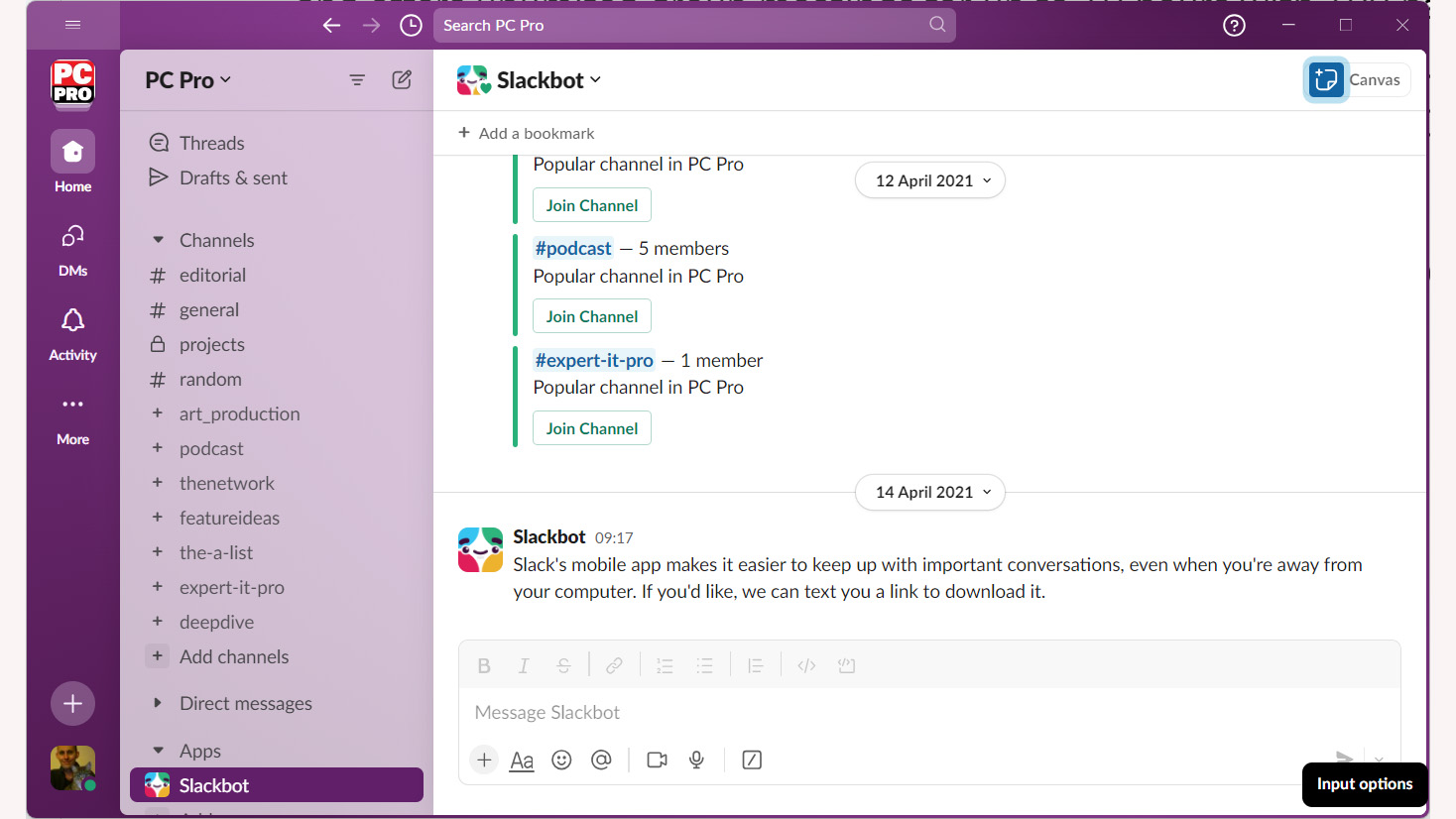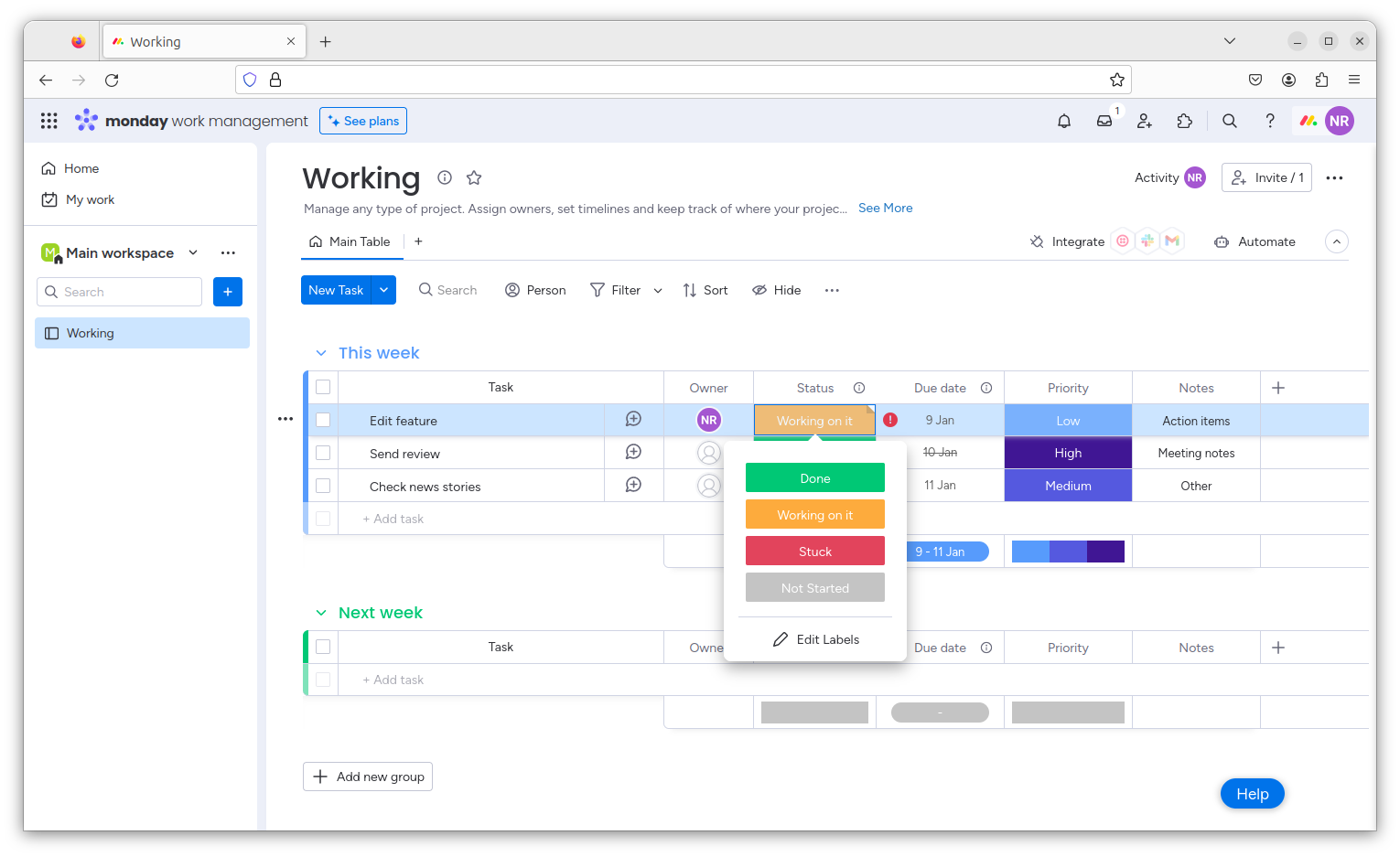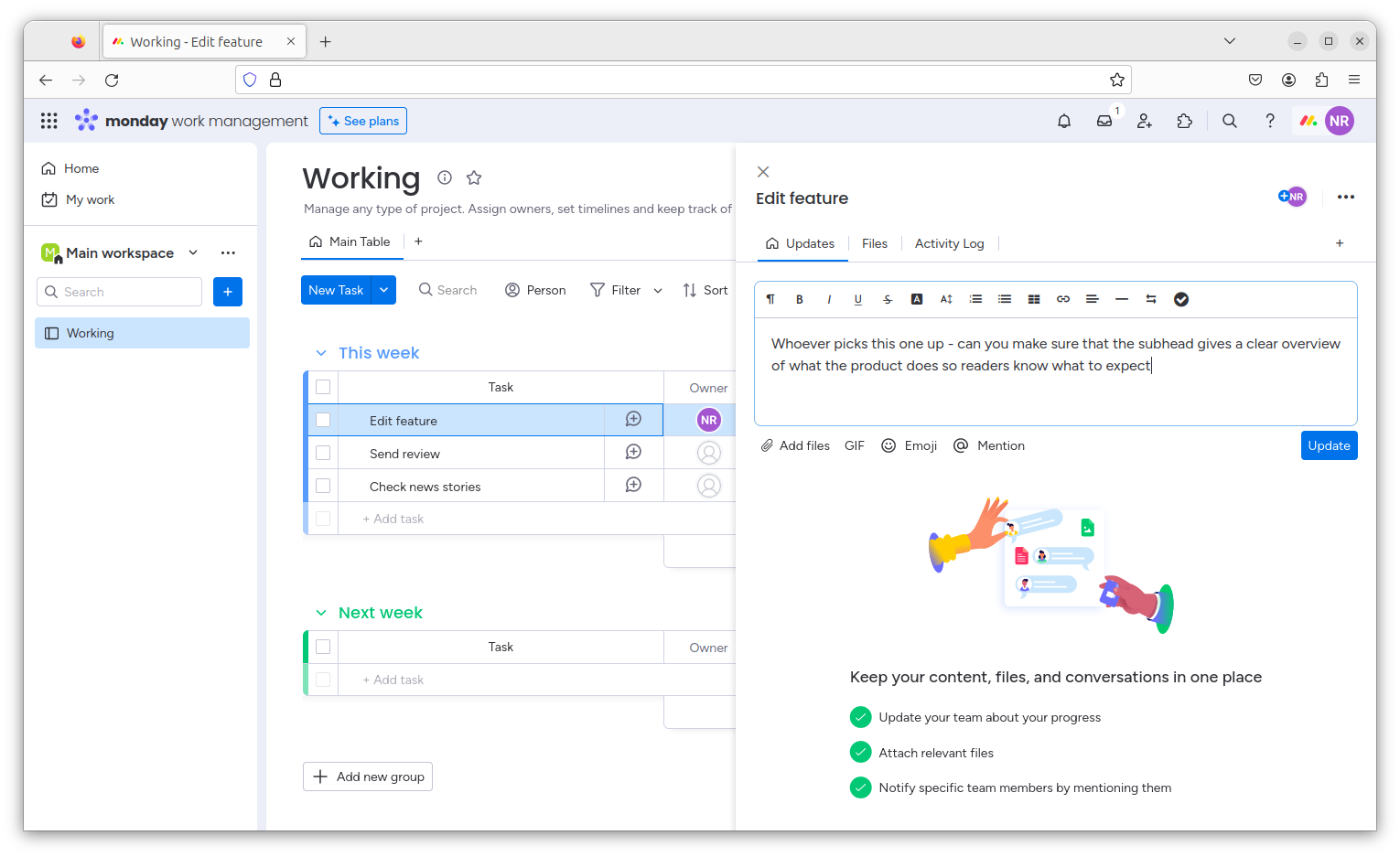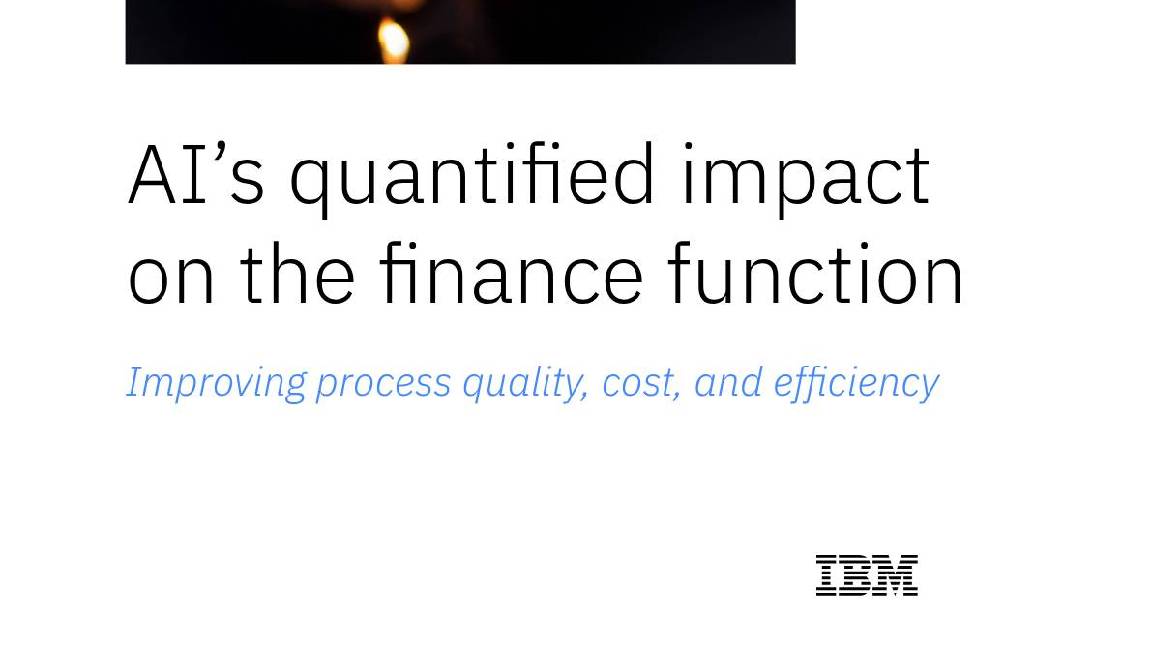Monday.com review: Work management platform works best when you pay for it
The versatile 'Work OS' skilfully balances power, flexibility, and ease of use

-
+
Simple-to-set-up automation
-
+
Flexible views for organizing tasks
-
+
Integration with common third-party apps and services
-
+
Easy to use
-
-
Free tier is limited to two seats and lacks many compelling features
-
-
Some integrations attract additional fees
-
-
No integrations or automation in the basic plan
Monday.com is a project management tool. It's also a process monitoring platform, team management hub, low-code development environment, and more. What looks at first glance like a spreadsheet with added smarts is, in fact, a flexible hub for managing and monitoring a distributed workload, keeping teams on the same page, and tracking projects as they progress. It's so flexible that there are few teams for which it couldn't sit at the heart of their ongoing business.
READ MORE

There are three distinct modules to the Monday.com platform. Here, we're looking at Monday.com for Work Management, but this is supplemented by CRM and Dev environments. The first of these helps with lead capture, sales pipelines, and customer onboarding, while the Dev option eyes sprint management, bug tracking, and roadmap planning. There's some commonality between them, chiefly in the way they present information, which is tied to tasks that progress through distinct stages as work is completed.
Each is built around a board, much like a spreadsheet database hybrid, that can be sorted, arranged, and split as appropriate. So, if you have separate teams responsible for discrete steps in an overall process, you could define these within your table. As a member of one team marks their work complete, automation (see below) could move it from their section of the board to the next, for an at-a-glance overview of the current state of play.
Monday.com: Sign-up and pricing
Sign-up is a breeze. Specify a name, password, and company, select what you'd like to manage – legal, HR, operations, and so on – and where you want to focus first. This could be contact management, strategic planning, your sales pipeline, or a dozen other options. You can then start inviting colleagues to collaborate. Beyond this, there's a simple wizard that will help you set up your first board so you can start using it right away, even before your colleagues sign up.
If you're using the free tier, you can enroll two seats in total, and organize up to 200 items on three boards. Beyond that, you're paying on a per-seat per-month basis, subject to a minimum of three seats. So Basic, which lifts the restriction on the number of boards and items you can manage, costs £8 per seat per month, equivalent to a starting price of £288 a year if you pay upfront, where you benefit from an 18% discount, or £396 if you split the cost 12 ways.
Three other tiers, each of them more expensive, naturally push things further. Standard, starting at £13 per seat per month, introduces timeline and Gantt views, guest access, automations, and integrations. Pro (£21 per seat per month) includes private boards, chart views, time tracking, and the ability to use formulas to perform calculations on your data. And Enterprise, for which you'll need to discuss the fee with Sales, improves on existing security, automation, integration, and permissions controls.
Monday.com: Spreadsheets
At its simplest, Monday.com is a smart table with columns for tasks, owners, status and so on. You can use it to plan work, assign tasks, and monitor progress. So far, so simple, but dig deeper and it's a lot more accomplished.
Sign up today and you will receive a free copy of our Future Focus 2025 report - the leading guidance on AI, cybersecurity and other IT challenges as per 700+ senior executives

If the table layout doesn't suit your way of working and you're signed to Standard or above, switch to the calendar or timeline, see how sequential jobs rely on earlier tasks with a Gantt chart, or use a kanban board like you'd find in Trello.
All data can be input and managed manually, with users populating cards and assigning them to teams or individuals. However, pay for the Standard tier or above, and you can integrate the third-party tools you already use elsewhere. More than 200 apps, including Teams, Slack, Gmail, and Excel, can share data with the platform. You could create a task directly from a message received in Gmail, or build a Monday.com dashboard widget drawing data from QuickBooks.
Some of these integrations are free, but not all. You can connect to DocuSign, track issues in Github, or use Ziflow to share and review creative assets without paying anything extra – but, depending on the extension you choose, you could be looking at $4 a month to embed Microsoft Office files, and between $50 and $750 a month to integrate Zoom phone. As a rule of thumb, if the integration is developed by a third party, it's more likely you'll need to pay. The Microsoft and Zoom examples cited above are each a case in point: neither Microsoft nor Zoom were the original developers of the add-ons in question.
Monday.com: Low-code programming
Where a feature doesn't already exist, you may be able to develop it yourself using no-code/low-code programming. The idea behind no-code/low-code is that teams are given the tools they need to produce their own workflows. The benefits are obvious: so long as they have a clear idea of how the workflow will operate and don't put company data at risk, they can avoid writing lengthy spec documents and instead produce the program themselves, rather than sharing a central development resource with other departments, and waiting for their job to reach the top of the stack.
If you've ever used IFTTT, which relies on conditions, tests, and actions, the process will be familiar: test for condition X and, if met, do Y. Start by picking an option from a 'When this happens' menu, like 'date arrives', 'status changes', or 'update created', then pick an outcome: move an item to a group, send an email, create an item in a board, and so on. Many outcomes have options, too, so, to dig further into the email-sending example, you can specify the recipient, subject line, and body copy, and drag in variables like item names, status, and due dates. Use this to notify team members when they've been assigned a task and there will be no excuse for projects running late.
The number of integrations and automation you can set is determined by your tier. Standard gets you 250 actuations of each, rising to 25,000 if you upgrade to Pro. You don't get any on the free plan, which is fair enough, but we think it's a bit stingy that Basic loses out, too.
Monday.com: Workflow

Monday.com bills itself as a Work OS. Its low-code programming features probably justify this on their own, but additional tools, like file sharing and the ability to attach chat threads to individual board items go a long way to giving them greater context and helping keep the team focused on a single environment, in much the same way that the tools for sharing within context do in platforms like Teams and Slack.
RELATED RESOURCE

Gain operational benefits through AI
Separately, a Workdocs feature provides space for less specific collaboration where colleagues can chat, draw up lists and checkboxes, brainstorm, share images, and more. Team members can contribute simultaneously, and everything is saved automatically. You can link Workdocs to one another, other users, and even embed a board inside a Workdoc for a single point of reference.
Workdocs first appeared in 2021 but other additions, like the button column, are more recent. Implement this, and you can tie a specific action to a button embedded in your board, by completing a simple form – much as you would when setting up an automation. Other recent additions include CSV imports, automatic task assignment, keyboard navigation, and more granular board filtering.
Perhaps inevitably, AI also makes an appearance. Built on Azure OpenAI, Monday.com suggests you'd use it to quickly define the tasks required to complete common projects, summarise documents, or develop formulas to embed in a board and analyze its contents.
Monday.com: Integration with rival platforms
You can't argue that Monday.com lacks a USP – but that's not to say it lacks rivals. However you organize your tasks, whether you prefer kanban, Gantt, or the smart table, the board is its central focus and, for our money, its strongest appeal. Additional features, like chat and AI, are logical extensions, but not something you can't find elsewhere.

Teams and Slack are both working hard to integrate AI, and they have document sharing and live collaboration features built in, much like Monday.com. Each is fully tooled to act as a team hub, and you can access features of project management tools, like Teamwork.com, Trello, and even Monday.com, through extensions. The Monday.com extensions for Slack and Teams let you add items to boards from within either platform, so long as you're signed up to Monday.com's Standard tier or above.
Monday.com: Is it right for you?
As is common across the SaaS landscape, you can sign up and get started for free. However, where Slack and Teams offer pretty much anything smaller organizations could need in their gratis plans, that's not the case with Monday.com. Here, the Free tier limits you to two seats, three boards, and 200 items (which you can increase to 1000 through referrals). If it could stretch this to three seats, we could live with the three-board limit – but, depending on your business, that 200-item start point could be an issue.
Monday.com claims that the Standard tier, at £13 per seat per month, subject to a minimum of three seats, is the most popular option, and it's not hard to see why. This level introduces automations and integrations; timeline, Gantt, and calendar views; Zoom integration; and guest access. You'll also benefit from the custom fields, unlimited boards, and unlimited documents that carry over from the £11 per seat per month Basic plan.
Even if you only make light use of the platform, paying for the Standard tier gets you a lot of features at a very fair price, which makes it easy to recommend.
Nik Rawlinson is a journalist with over 20 years of experience writing for and editing some of the UK’s biggest technology magazines. He spent seven years as editor of MacUser magazine and has written for titles as diverse as Good Housekeeping, Men's Fitness, and PC Pro.
Over the years Nik has written numerous reviews and guides for ITPro, particularly on Linux distros, Windows, and other operating systems. His expertise also includes best practices for cloud apps, communications systems, and migrating between software and services.
-
 Gender diversity improvements could be the key to tackling the UK's AI skills shortage
Gender diversity improvements could be the key to tackling the UK's AI skills shortageNews Encouraging more women to pursue tech careers could plug huge gaps in the AI workforce
By Ross Kelly Published
-
 Researchers claim Salt Typhoon masterminds learned their trade at Cisco Network Academy
Researchers claim Salt Typhoon masterminds learned their trade at Cisco Network AcademyNews The Salt Typhoon hacker group has targeted telecoms operators and US National Guard networks in recent years
By Emma Woollacott Published
-
 HPE says unified channel strategy won't force Juniper partners to generalize
HPE says unified channel strategy won't force Juniper partners to generalizeNews Does the company embrace specialists or want a full portfolio push? The answer, it seems, is both
By Jane McCallion Published